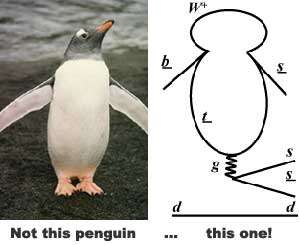Physics: Hunting the Penguin During BaBar's Long Run

BaBarians are hot on the trail of penguins. The BaBar collaboration is hunting for signs of new physics - perhaps supersymmetry, or perhaps the Higgs particle - in 'penguin modes', rare channels of decay from B mesons to other particles.
They hope to catch their quarry with their physics net. This is a set of data so huge that the current 15-month run will double the amount of data collected by the BaBar experiment during all previous runs from 1999 to 2004.
"There have been intriguing hints for new physics in penguin modes, which makes this a hot topic as we pursue the doubling of our data sample by next summer," said BaBar Spokesman David MacFarlane.
The search for new physics among penguin modes and other rare decay channels is one of many research goals for the international collaboration during the current run. It will take the vast amount of new data that the PEP-II accelerator is providing, and BaBar is recording, to be sensitive to tiny effects involved as well as to attain the statistical significance needed to possibly resolve whether new physics effects are taking place.
The current run started mid-April 2005, paused briefly from mid-October to mid-November to re-certify accelerator safety systems and upgrade PEP-II vacuum chambers, and will continue through July 31, 2006. BABAR also took advantage of the down time to install new drift chamber electronics. These will allow full exploitation of the increasing luminosity delivered by PEP-II. In addition, the experiment is benefiting from upgrades to one-third of the muon identification detector.
The PEP-II accelerator produces B mesons and their anti-particle, B-bar mesons. Both decay into other particles through the weak force. But the matter and antimatter particles decay at different rates because of an asymmetry in the behavior of the weak force (it violates charge-parity symmetry).
According to the Standard Model of known physics, this asymmetry should remain the same whether decays occur in a particular set of penguin channels or in the more common ‘charmonium’ modes. But the data to date indicates that in some of those penguin decays, there seems to be far less asymmetry than seen in the charmonium modes of decay. If this holds up, it means some kind of new physics is showing up in these rare decays—thanks to quantum loops.
Penguin modes, but not charmonium modes, are dominated by quantum loops. A loop means that a particle such as a W, which mediates the weak force, can materialize out of thin air for very brief times—despite apparently violating energy conservation—and then disappear. These brief-lived virtual particles can be W bosons, or they could be other particles with similar behavior—say a charged Higgs particle (which physicists still ardently seek) or a neutralino (one of the proposed supersymmetry particles).
If these not-yet discovered particles exist, they could show up in penguin loops and alter the expected asymmetry between matter and antimatter decays. This makes decays involving loops very sensitive to new physics at high masses.
"Each individual penguin mode might have a different contribution from new physics," said Riccardo Faccini, BaBar Physics Analysis Coordinator.
Indeed, recent papers on two new types of penguin decays showed that one follows standard model physics and the other suggests that non-standard physics might be influencing the decays. B-factory physicists are also looking for new physics in other rare decays with loops, such as tau and charm particle decays.
BaBar experimenters hope to have a much better understanding by the end of this run. The current average of all penguin channels shows about three-sigma effect for new physics, still below the five-sigma signal usually needed to claim a discovery. Even if these hints aren’t confirmed, the measurements made by BaBar and by Belle, the B-factory in Japan, will constrain where new physics could be found. The B experiments can probe for new physics at much higher energies (500 GeV) than produced in the collision events (about 10 GeV) because virtual particles can have any mass. These constraints will ultimately help experiments at the Large Hadron Collider currently being built at CERN interpret any discoveries made by directly producing new physics particles.
Penguin decays are elusive prey. Out of 400 million events, BaBar has measured only several hundred of them. Fortunately, the hunters are getting smarter.
"We have developed quite refined tools," Faccini said. "The doubling of the data set is really important because of the much improved sensitivity. We have a very good silicon vertex tracker to measure these different modes and in recent years we’ve been learning how to squeeze every last bit out of it. We also have refined our background-fighting abilities."
The PEP-II team is also on their side, delivering a record luminosity of just over 1x1034/cm2/s in the last few days before the mid-run downtime in October. The accelerator team has plans for a further 20 percent improvement in luminosity before next summer. They also expect an almost doubling of luminosity after they install major improvements in the fall of 2006.
Source: Stanford Linear Accelerator Center (By Heather Rock Woods)
















